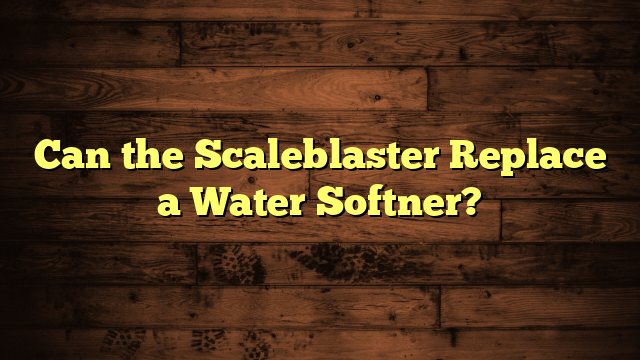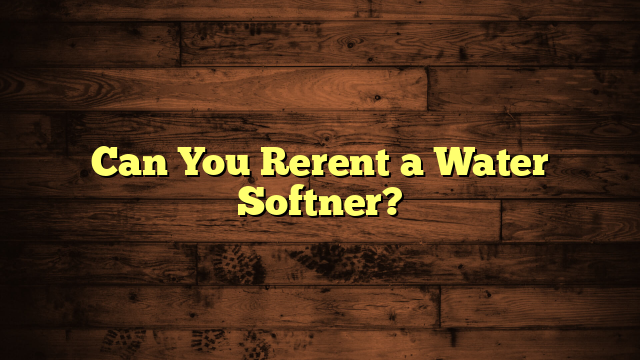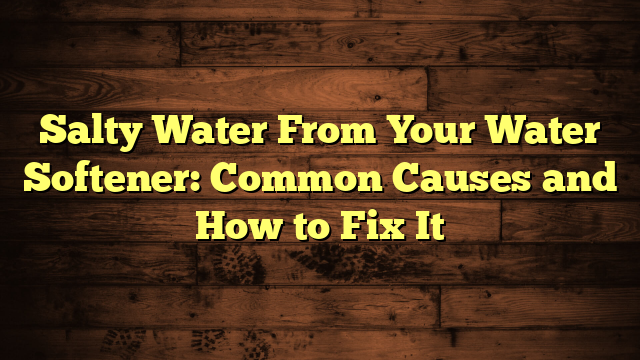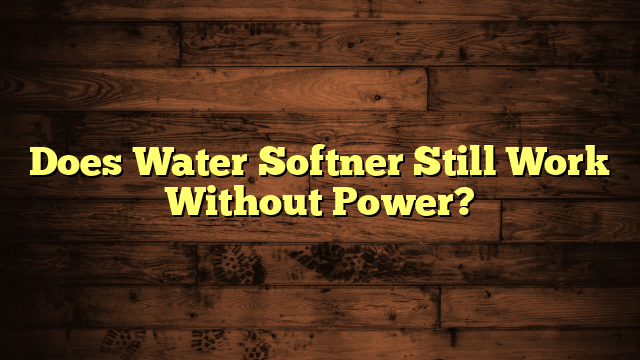Can the Scaleblaster Replace a Water Softner?
Isn't it a coincidence that many homeowners are turning to the Scaleblaster just as traditional water softeners face criticism for their salt reliance? You might be wondering if this innovative device can truly replace your existing system. While Scaleblaster claims to tackle hard water issues without the hassle of salt or maintenance, the effectiveness can vary based on individual circumstances. So, is it worth considering this alternative for your home? The answer may surprise you as we explore the nuances of both options and what they mean for your water quality.
Key Takeaways
- Scaleblaster uses electromagnetic waves to prevent scale buildup, making it a viable alternative to traditional water softeners.
- It requires no salt, reducing maintenance and operational costs compared to traditional ion exchange systems.
- Scaleblaster installation is straightforward and can be done as a DIY project, saving on labor expenses.
- Users report improved water quality and reduced mineral buildup, though effectiveness may vary based on water mineral content.
- Scaleblaster offers significant long-term savings on maintenance and salt purchases, appealing to eco-conscious homeowners.
Overview of Scaleblaster Technology
Scaleblaster technology offers a unique approach to tackling hard water issues in your home. Unlike traditional methods, this innovative water treatment system doesn't rely on salt or chemicals.
Instead, it uses electromagnetic waves to alter the structure of calcium and magnesium minerals found in hard water. This change prevents these minerals from forming scale and buildup in your pipes and appliances.
When you install a Scaleblaster unit, you'll notice a difference in your water quality. The system works by emitting a signal that resonates with the hard water, effectively changing the way these minerals behave.
As a result, you won't experience the same scale problems as before, leading to longer-lasting plumbing and appliances.
How Water Softeners Work
Water softeners work through a process called ion exchange, where hard water minerals like calcium and magnesium are replaced with sodium ions.
This method effectively reduces the hardness of your water, preventing scale buildup in your pipes and appliances.
Understanding how this process functions can help you choose the best solution for your home's water quality.
Ion Exchange Process
At the heart of effective water softening lies the ion exchange process, a method that transforms hard water into a more manageable form. This process involves exchanging calcium and magnesium ions, which contribute to water hardness, with sodium or potassium ions.
When you use a water softener, water passes through a resin bed filled with these sodium or potassium ions. As the hard water flows through, the resin beads attract and hold onto the calcium and magnesium ions, releasing the sodium or potassium ions into the water instead.
Over time, the resin beads become saturated with hardness ions, which is why you'll need to regenerate the system periodically. During this regeneration, a concentrated salt solution is flushed through the resin, washing away the accumulated calcium and magnesium ions and replenishing the sodium or potassium ions.
This cycle guarantees that your water remains soft and suitable for various household uses.
In essence, the ion exchange process is a proven method of water treatment that effectively reduces the negative impacts of hard water, providing you with softer, more manageable water for your home.
Hard Water Minerals
Hard water contains minerals like calcium and magnesium that can cause a range of issues in your home, from limescale buildup in pipes to dull laundry.
These hard water effects aren't just annoying; they can lead to costly repairs and replacements over time. When these minerals accumulate, they form deposits that can clog plumbing fixtures and appliances, reducing their efficiency and lifespan.
Water softeners work by removing these hard minerals, effectively preventing mineral buildup. They typically use a process called ion exchange, where sodium ions replace calcium and magnesium ions in the water.
This process transforms hard water into soft water, helping you avoid those pesky problems associated with hard water effects.
You might notice a difference not only in your plumbing but also in your skin and hair after using softened water. Your soap will lather better, and your laundry will come out brighter and cleaner.
Benefits of Using Scaleblaster
While many homeowners seek solutions for scaling issues, the Scaleblaster offers a unique alternative to traditional water softeners.
This innovative system provides several compelling benefits that make it an attractive choice for treating hard water.
Here are some Scaleblaster benefits you might appreciate:
- Cost-Effective: The Scaleblaster typically has a lower upfront cost and doesn't require salt or chemicals, reducing ongoing expenses.
- Environmentally Friendly: Unlike traditional systems, the Scaleblaster doesn't discharge salt into your water supply, making it a greener option.
- Easy Installation: You can install the Scaleblaster yourself, saving on professional installation fees and time.
- Preserves Hard Water Advantages: With the Scaleblaster, you can maintain some of the beneficial minerals found in hard water, which can be good for your health.
Limitations of Scaleblaster
Some homeowners may find that the Scaleblaster isn't a one-size-fits-all solution for hard water issues. While it can reduce scale buildup, its limitations of effectiveness can vary from household to household.
For example, if your water has extremely high mineral content, you mightn't notice significant changes. Unlike traditional water softeners, which physically remove hardness minerals, the Scaleblaster alters their behavior, which may not work for everyone.
Additionally, long term durability can be a concern. Some users report that the device loses effectiveness over time, and factors like water temperature and flow rate can influence its performance.
If you're looking for a permanent fix, relying solely on a Scaleblaster might lead to disappointment down the line.
Moreover, it's important to take into account that the Scaleblaster doesn't eliminate hard water's effects entirely. You might still experience issues like soap scum or mineral spots on dishes.
Cost Comparison: Scaleblaster vs. Water Softener
When considering solutions for hard water issues, cost often plays a significant role in the decision-making process. A cost analysis comparing the Scaleblaster and traditional water softeners reveals a stark difference in both upfront and ongoing expenses.
Here's a quick overview to help you weigh your options:
- Initial Investment: Scaleblaster typically costs between $400-$600, while water softeners can range from $1,000-$3,000.
- Installation Costs: Scaleblaster usually allows for easy DIY installation, saving you labor costs, while water softeners often require professional installation.
- Maintenance Expenses: Scaleblaster has minimal maintenance, focusing on the occasional change of filters, while water softeners need regular salt refills and system checks.
- Operating Costs: Water softeners consume electricity and water for regeneration cycles, while Scaleblaster operates with minimal energy usage.
This price comparison not only highlights the lower initial and ongoing costs of the Scaleblaster but also indicates potential long-term savings.
User Experiences and Testimonials
When it comes to choosing between a Scaleblaster and a water softener, real-life experiences can provide valuable insights.
Many users share their effectiveness in tackling hard water issues, while others highlight installation and maintenance aspects that you might find surprising.
Let's explore what people have to say, so you can make a more informed decision for your home.
Real-Life Experiences
Real-life experiences reveal a lot about the effectiveness of Scaleblaster and traditional water softeners. From user reviews and personal anecdotes, it's clear that opinions vary widely.
Here are four key observations from users:
- Cost Savings: Many users report significant savings on salt and maintenance costs with Scaleblaster compared to traditional softeners.
- Installation Ease: Several testimonials highlight how easy it's to install the Scaleblaster, often requiring no professional help.
- Water Taste: Some users mention a noticeable difference in water taste, preferring the unprocessed flavor from Scaleblaster over softened water.
- Long-term Effects: A few personal anecdotes suggest that while Scaleblaster may take longer to show results, its long-term impact on reducing scale buildup is impressive.
While experiences vary, these insights can provide valuable context as you consider your options.
It's crucial to weigh these user reviews against your specific needs and preferences.
Ultimately, your choice might depend on what matters most to you: cost, installation ease, taste, or long-term maintenance.
Effectiveness in Hard Water
User testimonials shed light on the effectiveness of Scaleblaster and traditional water softeners in dealing with hard water issues. Many users report that after installing Scaleblaster, they noticed a significant reduction in mineral buildup in their plumbing and appliances.
One homeowner shared that they no longer experienced the frustrating white residue on dishes or the scaling in their showerheads, which had been a common problem due to hard water.
Others expressed skepticism initially, wondering whether a system without salt could really compete with traditional water softeners. However, after a few weeks, they began to see improvements.
Users mentioned that their laundry felt softer, and their skin was less dry after showers, indicating that the Scaleblaster was effectively managing their hard water problems.
While not everyone experienced the same level of satisfaction, many found that the Scaleblaster offered a viable alternative to traditional systems.
It's clear that, for those struggling with hard water, user experiences suggest that Scaleblaster can make a meaningful difference.
The choice ultimately depends on your specific needs and preferences, but the testimonials certainly highlight its effectiveness in reducing the impact of hard water.
Installation and Maintenance Insights
Many users find the installation process of Scaleblaster to be straightforward and hassle-free, especially in comparison to traditional water softeners.
If you're considering this option, here are a few installation tips to keep in mind:
- Choose the Right Location: Place the unit near your main water supply line for best results.
- Follow the Manual: The included instructions are clear and easy to follow, making the setup smooth.
- Check Compatibility: Verify your plumbing system is compatible with the Scaleblaster for greatest performance.
- Take Your Time: Don't rush through the installation; a careful setup pays off in the long run.
After installation, maintaining your Scaleblaster is just as important.
Most users report minimal maintenance routines, typically involving periodic checks to confirm it's functioning correctly.
Unlike traditional water softeners that require salt replenishment, Scaleblaster requires no such upkeep, allowing you to enjoy softened water without the extra hassle.
Installation and Maintenance Considerations
When considering installation and maintenance for a Scaleblaster or a traditional water softener, it's important to weigh the differences in complexity and long-term upkeep.
Installing a Scaleblaster is generally straightforward; you simply attach it to your main water line, following the provided installation tips. You won't need to worry about plumbing alterations or the extensive setup often required for traditional water softeners.
In terms of maintenance requirements, the Scaleblaster stands out again. It requires minimal upkeep, mainly just ensuring that the power supply remains connected and functional.
In contrast, traditional softeners need regular salt refills and occasional cleaning of the resin tank, which can be more labor-intensive over time.
For those looking for a hassle-free solution, the Scaleblaster is appealing due to its ease of installation and low maintenance demands.
If you're considering which option suits your lifestyle better, think about how much time and effort you're willing to invest in upkeep. With the Scaleblaster, you can enjoy softened water without the extra chores often associated with traditional systems.
Final Thoughts on Replacement
How do you decide if it's time to replace your current water treatment system? Making the switch to a Scaleblaster can be a significant decision, especially when considering your needs and the benefits it offers. Here are four key points to ponder:
- Water Quality: Are you still facing hard water issues despite your current system?
- Maintenance Costs: Are the ongoing maintenance costs of your water softener becoming burdensome?
- Environmental Impact: Do you want to adopt a more eco-friendly solution that reduces salt use and wastewater?
- Long Term Savings: Are you looking for a cost-effective alternative that can save you money over time?
In evaluating these factors, you'll find that the Scaleblaster presents a compelling case. It not only addresses hard water concerns effectively but also minimizes the environmental impact associated with traditional water softeners.
Plus, over time, you may enjoy significant long-term savings on maintenance and salt purchases. Ultimately, replacing your current system with a Scaleblaster can lead to a more efficient, sustainable, and cost-effective solution for your home's water treatment needs.
Frequently Asked Questions
Does Scaleblaster Use Salt or Chemicals Like Traditional Water Softeners?
Scaleblaster doesn't use salt or chemicals like traditional water softeners. Instead, it employs salt alternatives, relying on a unique chemical composition to combat hard water without the need for sodium or harsh substances.
Can Scaleblaster Help With Existing Hard Water Stains?
Yes, Scaleblaster can help with existing hard water stains. By using effective hard water solutions, you'll notice improved stain removal over time, making your surfaces cleaner and reducing the need for harsh chemicals.
Is Scaleblaster Effective in All Water Types?
Scaleblaster's effectiveness varies with water hardness and treatment methods. While it can reduce scale buildup in many conditions, it might not perform equally well in all water types. Testing your specific water quality is essential.
How Long Does It Take to See Results From Scaleblaster?
Imagine planting a seed; you won't see a flower immediately. Similarly, user experiences suggest you'll notice Scaleblaster's results timeframe varies, but many report improvements within weeks, transforming your water quality into something vibrant and invigorating.
Does Scaleblaster Affect Water Taste or Odor?
Scaleblaster typically doesn't affect water taste or odor greatly. However, many users report a water quality improvement over time, which can enhance the overall taste of your water, making it more enjoyable to drink.
Conclusion
In the quest for softer water, the Scaleblaster stands as a modern knight, wielding electromagnetic waves instead of a traditional sword. While it may not vanquish all the challenges a water softener does, it offers a compelling alternative for many homeowners, delivering benefits like cost savings and low maintenance. Ultimately, your choice depends on your unique needs and circumstances. If you're ready to embrace the future, the Scaleblaster might just be the champion you've been searching for.







